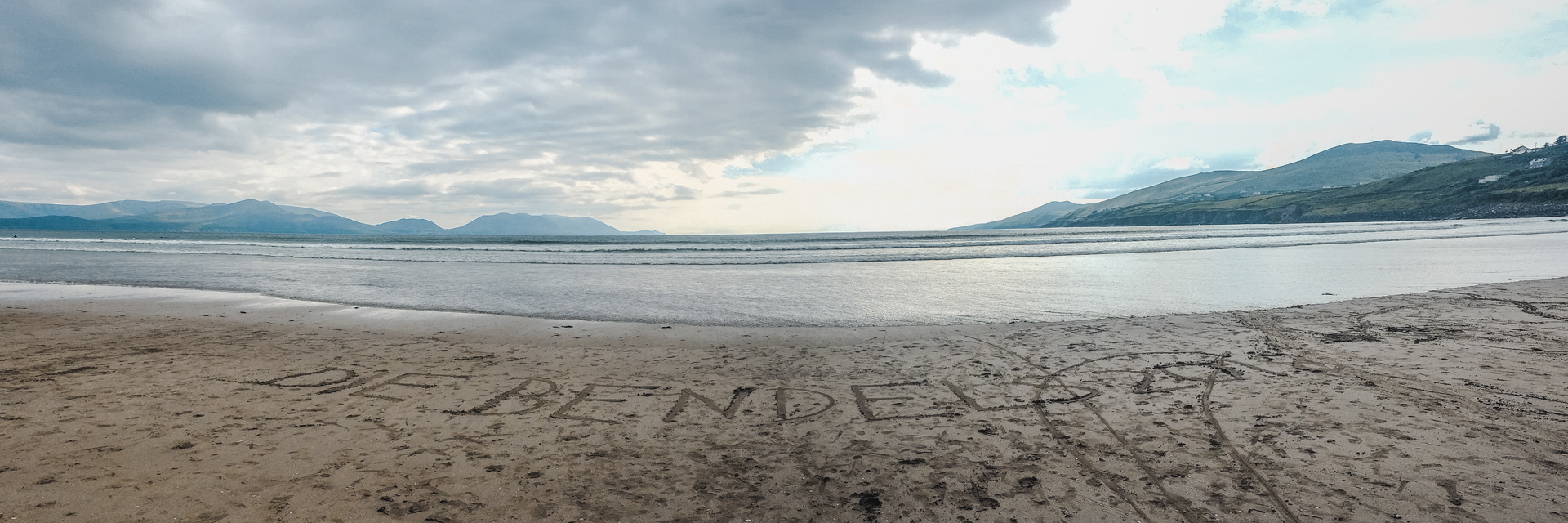After a first contact with Ireland in Dublin, my parents now returned to our home on the west coast with us, where they could properly get in touch with the land of our dreams. At this point they had no idea what else was waiting for them and how much better it would get! We gradually fulfilled our promise that the rest of Ireland is a thousand times more beautiful than Dublin by showing them a bit more of the beautiful landscape and culture of Ireland every day.
Attention: This blog post is the longest by far and nothing for lazy readers!
Our Home on the West Coast
When we arrived home late at night, of course I showed my parents our cottage despite the late hour. Completely thrilled and delighted by “Hotel Daughter”, they briefly sat down with us in front of the fireplace and let it all sink in.
The next day we played it safer – after all, my parents aren’t that young anymore and can’t be on the move every day. 😉 We just showed them the beach in Lahinch (unfortunately in bad weather) and made a nice walk in the evening sun in our neighborhood, where we met various animals.
The next day we first explored the surrounding area, including a secluded, idyllic lake,we haven’t been to yet. Once there, we were greeted by two white horses and affectionate dogs, that were only too happy to jump at us tail-wagging.
We continued our day trip in the nearby Burren at one of the largest of nearly 500 old ring forts here, the Caherconnell Fort. It was built in the 10th century for a high-ranking, possibly royal family, the lords of the region. In its heyday it was a huge fortress, which was in use until the 17th century. Each settlement phase left new houses and numerous artifacts behind. The wall of large stone blocks is about 12 meters thick and has a diameter of 145 meters. Due to an old elder bush, which grows by the ruins, the Ringfort – like many others – was called a fairy fortress. Early modern folklore connected supernatural stories with elder bushes as well as Cashel’s, which led to many people being afraid of entering such places and them remaining intact until today.
Only a few hundred meters further on, we then visited the most important and massive megalithic tomb of the Neolithic era that Ireland has to offer – the 5000-year-old Poulnabrone Dolmen. Along the way a sympathetic Irish man who spoke many languages was saling homemade jewelry. Of course, there was no passing for my mother and she had a bracelet with her name in Ogham runes, the ancient Celtic language, made.
But that wasn’t everything from the Burren yet – next we had a lunch break in the café of the Burren perfumery, a truly green oasis in the middle of the rocky landscape. We also gazed at the witches’ garden (as we call it), teeming with herbs and medicinal plants, here. It’s hard to believe what small green paradisiacal places are hidden in the midst of the barren, stony landscape!
On the way home, we stopped at the old church ruins and the cemetery of Kilnaboy – this historic site has some of the best views in Ireland – and at a small waterfall that flows into Inchiquin Lough. From here you have a fantastic view over the lake and the scenic, green surroundings.
As if this hadn’t been enough, we had a snug barbecue on our green meadow in the evening sun to round off the day. What a perfect day! 🙂
The next day we gave Lahinch another try. This time the weather was much better and we visited the beach about 1.5 hours before sunset, so that the atmosphere was as magical as we normally know it. The sunbeams once again broke through the clouds so breathtaking that you can only describe it as holy light.
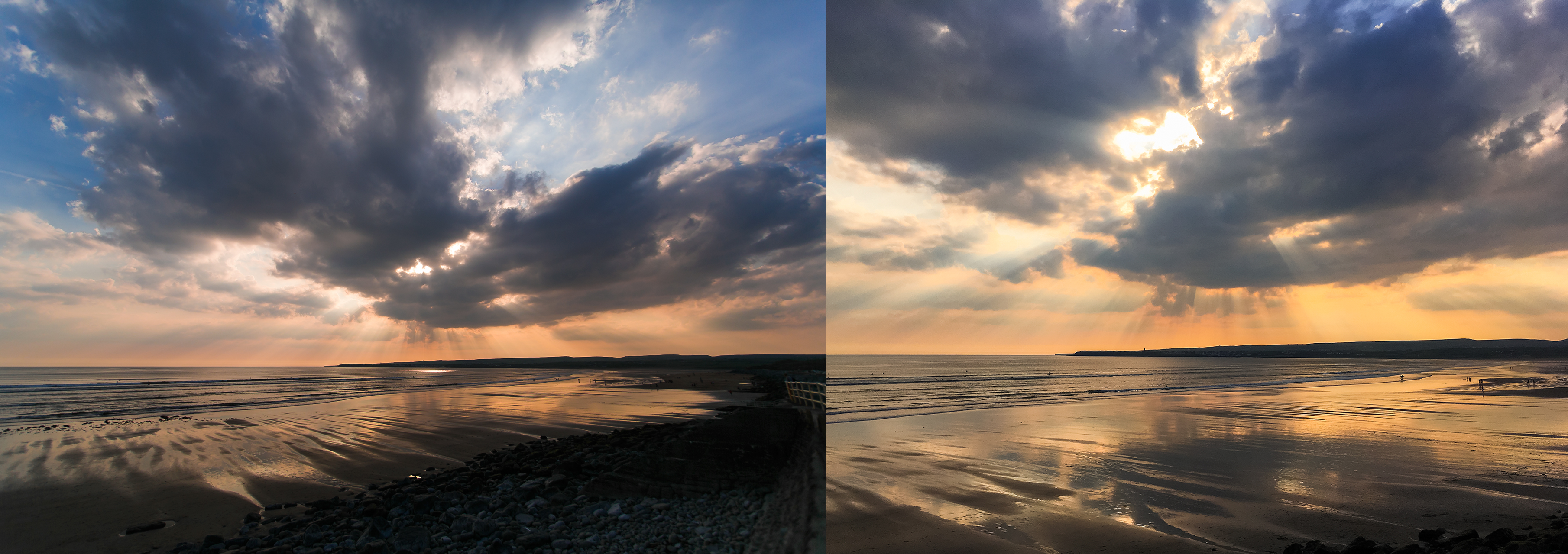
Afterwards it was time to beat this view at the nearby Cliffs of Moher, which my parents saw for the first time now. We stayed here until the sun kissed the horizon. We looked at the cliffs from different angles and Falk let his drone fly in the sunset – despite the ban – while we diligently waved into the camera. 😉 Thereby these beautiful pictures, we don’t want to hide from you, were created.
As soon as the blue hour struck, we went back home – not without stopping at St. Brigids Well, though. We’d already shown this strange holy well to Falk’s parents and presented it in the blog post „Our first visitors“ more detailed. Also my father bravely tasted the supposedly healing waters of the well, while my mother inspected the inscriptions that visitors had left on the stones.
The next day began less peacefully – Falk was suddenly sick and our car needed to see a garage for the first time. So I drove to Ennis alone with my parents, where we first handed over the car and then were brought to the town center. We were meant to pick it up again in four or five hours.
First we had a breakfast in a cute cafe. With renewed strength we then went on an extensive tour of the small town looking at the sights of Ennis and combing through antique shops.
Also, this week was the annual Ennis Town Festival „Fleadh Nua“ taking place at Bealtaine. There was a lot going on in the streets and the medieval old town seemed all the more lively. Street musicians played Irish music at some corners with accordion or guitar. No wonder – Ennis is Ireland’s hotspot for traditional Irish music. I can still remember how a big school class at the O’Connell column in the middle of the old town was celebrating and cheering for a group photo. Nobody seemed to have school today.
After a few hours of strolling through Ennis and having lunch, we were ready for the call to pick up our car. We waited 1 hour, we waited 2 hours, but still no call. After another hour we called again and again they delayed the pickup. At the end of the day, we had to wait until closing time, hence 6pm, till someone picked us up and drove us back to the garage. All in all we spent almost 9 hours in Ennis and the car was anything but repaired, but that’s another loooooooong story …
Island Hopping
The next day we „hopped“ over from the green main island to one of the offshore Aran Islands, which obviously shouldn’t be withheld from my parents. This time however, not the island closest to Doolin – Inis Oírr – was our destination, but the largest and most touristic of the three islands: Inis Mór, anglicized Inishmore. Many travelers who come to West Ireland visit only the 14.5 km long and 4 km wide island whose main attraction is a stone ring fort – or at least what’s left of it – enthroned on cliffs at dizzying heights.
After more than one and half an hour crossing over by ferry in great weather, we were picked up by a mini-bus and drove to the sights of the island. First, the Na Seacht dTeampaill, the Seven Churches, an old site consisting of several church ruins, monastic buildings and high crosses from the 8th or 9th century were on the schedule. For centuries it was one of the largest monastic sites and pilgrimage centers of western Ireland. Incidentally, it competed with the settlement of St. Enda, the school of St. Ciaran, who then laid the foundation for Clonmacnoise in the heart of the country (more in the blog post “The Irish Midlands” https://shamrock.blog/2018/ 11/18 / the-Irish-Midlands /). One of the tombstones with the inscription “7 Romans” manifest the former fame of this monastery because it even attracted students from imperial Rome.
Then we had a rustic Irish lunch in one of the few inns of the island. We then climbed up a long, stony path up to the most famous of the three prehistoric, more than 2000 years old stone forts of the island – Dún Aengus. Its massive stone walls reach to the edge of the approximately 60m high cliffs. The fascinating site was left as it is. No barrier, no fence prevents anyone falling down into the roaring waves of the Atlantic here – nothing for people with vertigo! From here you can enjoy a magnificent view of the sea, the stone island itself and the surrounding Aran Islands. Although this place is very crowded in summer season, the climb is worthwhile for that alone under good viewing conditions.
With the minibus we were then driven past other attractions, but I can’t remember exact details. In any case, Inis Mór has a lot more to offer and you can also explore the island by bike or jaunting car and stay overnight, e.g. at Aran Glamping.
At 5 o’clock in the afternoon we hopped back to the Irish mainland by ferry. There I showed my parents the Doolin pier and we finished the day with a whiskey, while talking with Irish holidaymakers from County Cork.
Exploring Ennistymon
After 2 or 3 days of being sickly Falk was able to come with us again the next day. Today my parents were meant to get to know our place of residence Ennistymon. It was Saturday, so we decided to visit the small weekly market first. Except for a few stalls with regional vegetables and cheese, however today was not much to find, where tomorrow the streets should be busy because of the annual cattle market. Nevertheless we took a few local treats with us.
Next we walked by the Falls Hotel to the spectacular, that already made the small town famous in the olden days (see one of our first posts). The drought period had already started and there wasn’t as much water in the river as usual, though.
In order to not having to renounce the view on the water, we sat down for lunch in the beer garden of the Pot Duggans, a relatively young Gastropub, who has already received some awards for its kitchen. In particular the Guinness Chocolate Cake has earned these awards! Unfortunately they didn’t release the recipe … It’s a nice place to stay in the shadow of the trees by the river, especially since on the other shore some hippies played guitar and sang along.
The musical entertainment program continued in the evening when we visited one of Ennistymon’s busiest pubs, Cooley’s Pub. The live music and the atmosphere there wowed not only mine but also Falk’s parents. We sat right in front of the musicians and were allowed to ask for songs. So in addition to songs like “Galway Girl” (of course the Irish song and not the new one by Ed Sheeran) or “Parting Glass”, also a funny Irish folk song about a German who came to Ireland (“German Clockwinder”) was sung. The text is as follows:
A German clockwinder to Dublin once came
Engelbert Schnuck was the ole German’s name
and as he winded the way up the strand
he played on his flute and the music was grand
Singin’ tu ra lumma tu ra loor a lumma tu ra lie a
A woman came out from Fitzwilliam’s square
she said her ol’ clock was in need of repair
She invited him in and to her delight
in lees than five minutes, he had her clock right
Singin’ tu ra lumma tu ra loor a lumma tu ra lie a
They sat down together, just takin’ in stock
when all of the sudden, there came a loud knock
in walked her husband, and oh what a shock,
for to see the ol’ German wind up his wife’s clockSingin’ tu ra lumma tu ra loor a lumma tu ra lie a
“Ah, wife Maryanne, ah wife Maryanne, ”
“why did ya take in, such an innocent man?”
“For to wind up your clock, leave me on the shelf”
“If your ol’ clock needs windin’ sure I’ll wind it me’self!”
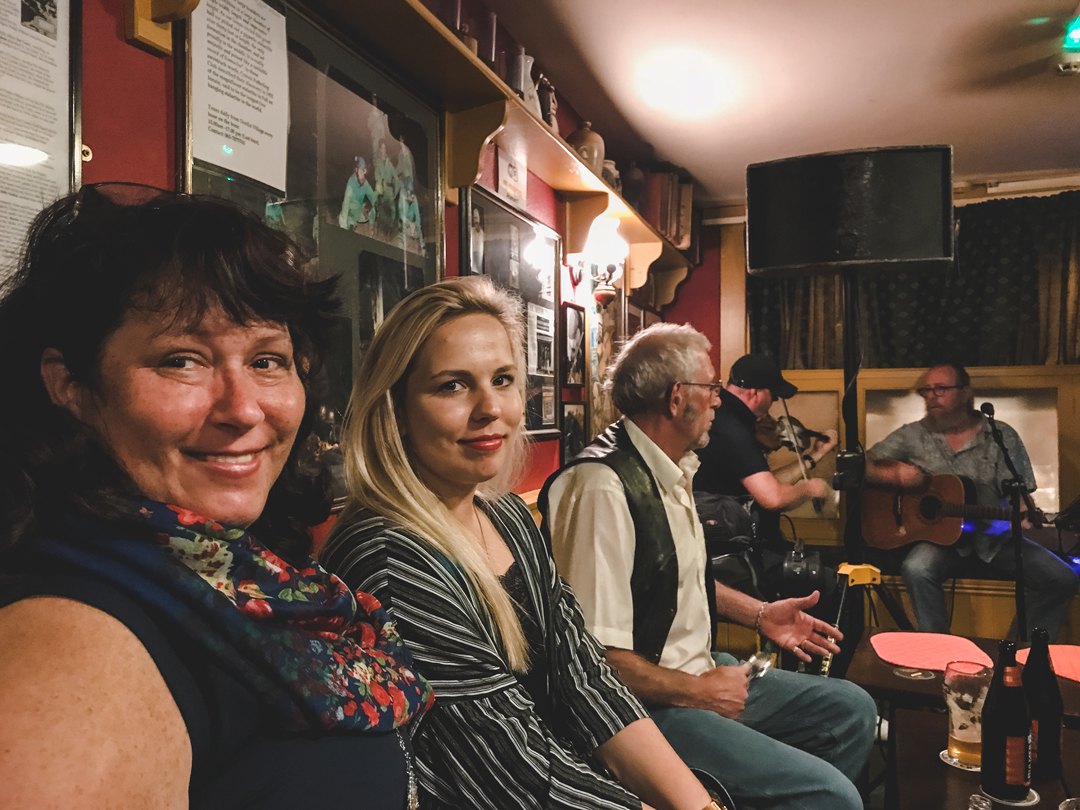
Galway’s Alleys
The next day we wanted to go to my favorite Irish city, but right at the beginning our way was blocked. The annual cattle market of Ennistymon took place and numerous horses and other cattle were examined and even ridden probationaly on the middle of the road. This view was just too good, we’d never seen anything like it. We gladly accepted to wait a while until we were able to continue.
We then decided to take the land route through the Burren in North Clare and along the coast instead of taking the fast route over the highway. That way we could admire the breathtaking views from the Burren over Ballyvaughan to the sea and visit the Dungaire Castle (among other things). Even the harbor village of Kinvara, where we had lunch, didn’t slip through our fingers.
In the early evening we finally arrived in Galway, the “most Irish” city of Ireland, because no one is able to hear as much Irish in the streets, shops and pubs as here. Moreover a quarter of the inhabitants are students and that is noticeable. The city is modern, unconventional and, in addition to many packed pubs and colorful streets teeming with live music, offers unbeatable entertainment for young and old alike. It may happen that the first thing you see on the street is a men’s band that is partly wrapped in women’s clothing. 😉 Throughout the year, the city is well filled and especially popular amongst younger visitors, for example us!
So we tried to infect my parents with our enthusiasm and took them to all our favorite parts of the city. After the main promenade full of live music and people, where we spoiled ourselves with overpriced drinks (I just want to remind of the Aperol Spritz for almost 20 €), we leisurely walked along Corrib River. We followed the river path to Nuns Island, on which the stately Cathedral of Galway sits. In order to let the evening come to an end merrily, we visited two of our favorite pubs – the O’Connells, reminiscent of the Diagon Alley, and the King’s Head, where you can experience excellent live music every night. The only one suffering was Falk, because he had to stay sober to bring us all home safely.
After this long trip we used the next day to relax. With 30 degrees it was the hottest day of the year so far and certainly the warmest day in years in Ireland. While my mother and Falk were busy in the house and garden, I drove to the beach in Lahinch with my father for a first swim in the freezing cold Atlantic. It was so cold that I wasn’t able to feel my feet in the water after only a few seconds. Really painful, but it was so refreshing and it was fun to dodge the wild waves trying not to get wetter than necessary. While we sat there and toasted with ice-cold drinks, we noticed other Germans sitting not far away from us and so we got into conversation with them. The nice couple has been here for the first time and totally thrilled from this place, too. The tide came very fast again and so we all had to flee from the cool water soon.
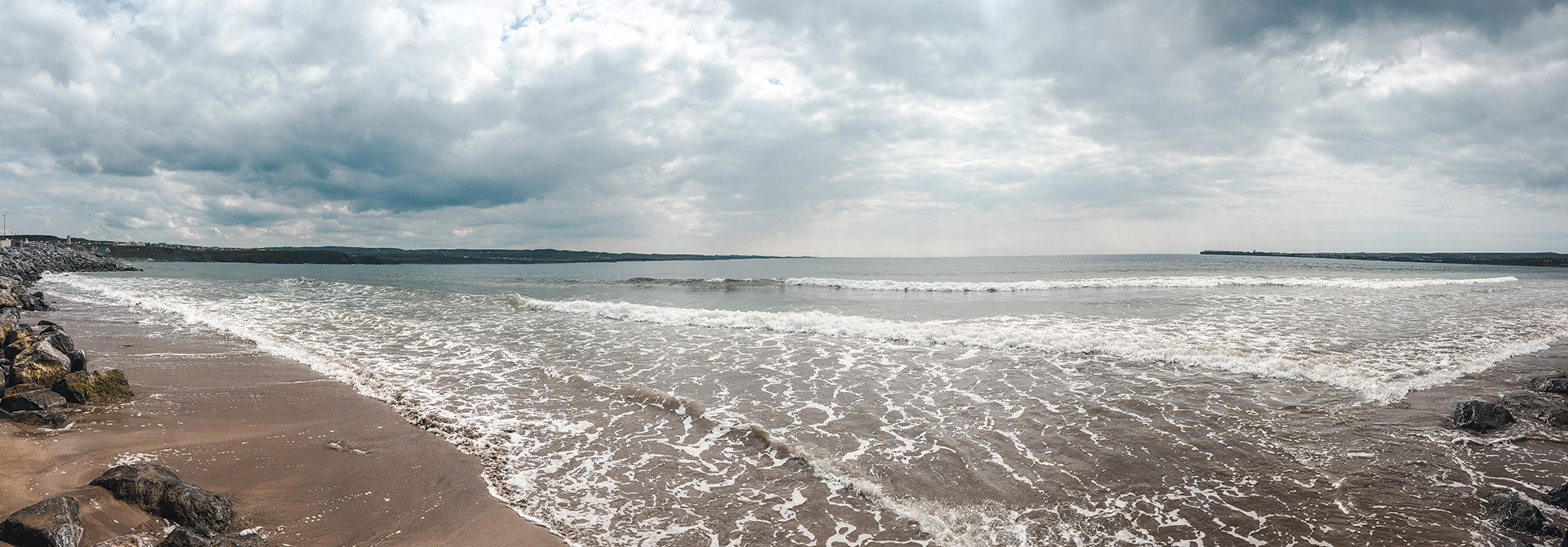
Checking out County Cork
The next day it was even warmer. In (for Ireland) unbelievable 32 degrees, we drove the long distance down to County Cork, where we arrived in the port town of Cobh (pronounced “cove”) in the afternoon. First we visited the evident, oversized granite cathedral of course. After we lit a candle in devotion to our loved ones, we walked between the roofs and colorful cottages of Cobh down to the port promenade, where the old, last pier of the Titanic can be found. In the Cobh Heritage Center, which is designed like a huge, old station hall, my mother insisted on being photographed with costumed Titanic women.
Then we searched for the most famous photo scene of Cobh. After a strenuous walk up steep streets, Falk eventually found, thanks to his size, the famous sight of colorful row houses with the cathedral and the sea in the background, hidden behind a high stone wall. This row of houses is also called “Deck of Cards”.
But now we hurried to Midleton – there our pre-booked tour of the Jameson distillery was meant to take place in the late afternoon. During the revealing and making-merry tour we learned for example that Irish whiskey is usually always distilled 3 times, whereas Scottish undergoes a 2-fold and American only 1-fold distillation. This is what’s supposed to make Irish whiskey the purest and tastiest “water of life” (in Irish “uisge beatha”). To test this, a tasting was conducted with some of us – including Falk and my dad, who, however, liked all the whiskeys, not only the Irish one. The Irish ripen most of their whiskey after distilling for at least three years in former US bourbon barrels. The American oak makes the whiskey soft and mild and the former bourbon gives the whiskey a vanilla honey note. The Jameson whiskey smells really good, but in terms of taste it’s nothing for me unfortunately. I stuck with a long drink consisting of a small sip of Jameson, lots of ginger ale and lime – yum!
Interesting side note: In Ireland so much whiskey is produced that grain needs cannot be covered by domestic production, which is why much is imported.
Following the tour, there was an even more extensive tasting of several Jameson varieties, I was the only one not taking part at because I was the driver. My parents and Falk, on the other hand, were pressure refueled with four generous whiskey samples in just 20 minutes and then staggered blissfully out of the Jameson building.
Alcohol on an empty stomach is not good, so after checking into our accommodation for the night, we went straight to Cork city center. In a rustic gastro-pub called “Thomond” we filled our stomachs while listening to Irish live music. During an evening walk through downtown Cork, lined with modern lanterns, we met Karl Marx and marveled at old buildings.
The morning after we were drawn back to Cork city center, more precisely to the English Market, a gigantic market for all kinds of food. My parents really like things like that, so we spent the entire morning here and let ourselves be entertained and advised by a fish vendors with comedian potential among other things. Then we strolled a bit through the alleys filled with people and street musicians and stopped every now and then for a few small purchases.
Later we ate our souvenirs from the English Market in Cork in our next destination, the Blarney Castle Garden. There’s nothing like a cozy family picnic made from fresh ingredients. Now it was time to explore the Blarney Castle and the spacious, beautifully landscaped gardens around it.
Blarney Castle and its approximately 25 hectares of gardens are one of the biggest visitor attractions in County Cork. This is mainly due to the Blarney Stone, the Stone of Eloquence. For more than 200 years, people, including numerous statesmen and literary giants, have been making a pilgrimage here and climbing the 100 steps to kiss the Blarney Stone. That’s right, year after year, thousands of people have been pressing their lips on this stone, hanging in dizzying heights and being hard to reach, for more than two centuries. But why? Well, the stone is said to have undeniable powers. Legend has it that the stone was formerly used as an oracle stone, similar to the speaking hat in the Harry Potter story, but for the selection of kings. Later he is said to have been brought to the Scottish mainland, where his prophetic powers were also used to determine the royal succession as the “Stone of Destiny”. When Cormac MacCarthy, King of Munster, sent 4,000 of his men to Scotland in 1314 to help Robert de Bruce defeat the English, the stone was split in two and brought back to Blarney. A few years later, a witch saved from drowning is said to have predicted the MacCarthys further magical powers of the stone:
„There is a stone there,
That whoever kisses,
Oh! He never misses
To grow eloquent.“
Whoever kisses this stone is supposed to be given the gift of fluency and eloquence. At least one of us – my mother – was willing to kiss the stone, which is most likely bursting with germs, by leaning back down despite back problems while being held by a professional human fixer. Unfortunately it wasn’t possible to check whether the stone was able to develop its magical powers, because my mother never had problems articulating anyway. Falk rather should’ve risked a kiss… but he has me for that! 😛
Apart from Blarney Stone, from the top of Blarney Castle you have an excellent view of the extensive surrounding parkland, consisting of blooming gardens, impressive avenues and numerous waterways. We started exploring Blarney Gardens immediately afterwards. We came at exactly the right time, because everything was beautiful green and blooming beautifully.
In total, we spent more than three hours at Blarney Castles and Gardens. The area is so extensive that we could have happily walked for another three hours, but the park closed and we were “kicked out”. At the latest when they turned off the water of the small waterfall, we knew it was time to go.
But not without stopping at the stone circle of the “Seven Sisters” for a short moment à la Outlander to be transported back to earlier times. Another legend says that the former king of Munster had seven daughters and two sons. One day it was time to go to war against a rival to defend his own country. He went into battle with his two sons at the helm – his army won, but not without paying a high tribute. His two sons died on the battlefield. On the way back, the army marched past this old druid stone circle, which is said to have stood here for millennia. In his grief, the king ordered his men to knock over two of the nine stones. To this day, this is supposed to commemorate the loss of his two sons while their seven sisters are still standing…
Enchanted by the beauty, diversity and history of the Blarney Castle and its gardens, we drove back home to County Clare the same evening.
Cliffs, Beaches & Sea
After my father and I had tested the still very cold water of the Atlantic Ocean a few days ago, we dared to go swim in the cool water together for the first time in persistently hot temperatures now. Where? Of course at the well-known Lahinch Beach, where the tide always makes the wide, gently sloping beach disappear surprisingly quickly. Because we already knew that, we preferred to store our towels and things on the rocks, which also serve as breakwaters.

The next day also took us back to the sea. After an extensive homemade Irish breakfast with hash browns, black & white pudding, beans in tomato sauce and much more, we showed my parents the rocky coast at White Strand near Miltown Malbay. Wildflowers littered the landscape with color.
Then we visited another beach, the Spanish Point Beach. Here we plunged into the cool waters again and my father built a stone tower. We also engraved our stay here in stone.
The sun was slowly creeping away behind a rising rain front, so we ended the swimming afternoon and drove to the Kilkee Cliffs and to various viewing points near them. We followed the route we had already taken on our first tour along the Loop Head Peninsula (see here). The dramatic play of rain clouds and sun rays breaking through the cloud cover increased the mystical sight of the cliffs. My parents loved the wild-romantic setting from the start. We almost seemed to be the only ones here again, so we could take our time and enjoy the views in peace. The Kilkee Cliffs are one of those pristine places in Ireland where you can still feel the country’s nativeness and true freedom. No wonder that my parents found this excursion to be the highlight of their first visit to Ireland and absolutely wanted to come back here again. Blissfully we left the Kilkee Cliffs when the rain threatened to set in and ended the evening comfortably in front of the fireplace playing cards.
We took the day before last with my parents easier. We stayed at home, my parents packed up and in the afternoon we went for a walk through the neighborhood. We met two very cute, old dogs who were very happy to cuddle with us. We also visited the Clouna Church, the village church not far from our house, for the first time.
In the evening my mother prepared a hearty roast for Falk as he was craving good old German food. Little did we know back then that a little later our only direct neighbor would stand in front of our door to invite us to a BBQ. So we spent the evening cheerfully with Dan and his family. Even if two cultures collided here and not everyone understood every word, it was a successful evening full of exchange.
A special Surprise
My parents’ return flight didn’t leave Kerry before evening. So for our last day there was enough time to explore another corner of Ireland. I had come up with something very special for that occasion! Just like back then with Falk’s parents, we first took the ferry between Killimer and Talbert in order to not having to take the long detour overland. Then we drove with my parents to Dingle Peninsula and to its “capital” of the same name. On the way there we saw incredibly green meadows, even though it rained so little lately. In the background we saw the sea – what a view!
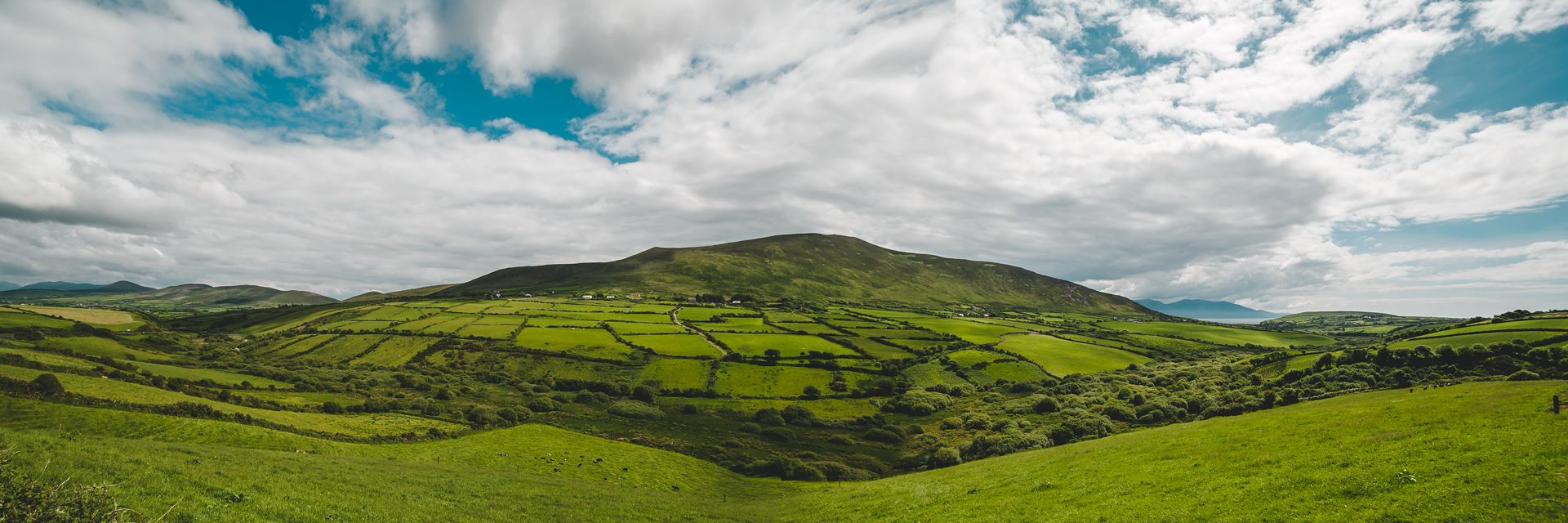
When I arrived in Dingle, I finally released the planned surprise: a boat trip on which you can watch dolphins! More specifically a dolphin – the local, tame but wild dolphin named Fungie, who has been at home in Dingle Bay for more than 35 years. Fungie even shows up so regularly that people get their money back if they don’t see him! At around € 60 for the four of us, this ain’t a bad promise.
When we left the small harbor, we didn’t really expect to actually see him. On this wonderful day we simply enjoyed the view of the Dingle bay and the colorful small town, moving further away. Somewhere at the end of the bay, where it merges into the open sea, a couple of tour boats gathered and circled an area in search of Fungie. He was a long time coming and just when we thought we were going back, he suddenly appeared!
Close next to us Fungie’s back fin suddenly appeared and then his entire gray back. He kept jumping out of the water and everyone was excited and happy. The other boats also became aware of him and came closer. Fungie was swimming between us now, surrounded by boats. If you hadn’t known better, you would have thought he was encircled and impelled, but that’s not true. Whether he stays because of the good air or the attention, one thing is certain: he is here voluntarily and doesn’t want to go anywhere else. Fungie has been a permanent guest since he literally popped up here for the first time in 1983. In the sheltered harbor of Dingle, where locals and visitors treat him as an honorary citizen, the intelligent animal seems to like it very much, especially because of the huge attention. This special dolphin has an impressive personality and loves to show himself – also to our delight. Sometimes he jumped high enough for us to fully admire him.
David Young, a journalist at the Irish Examiner, puts it this way: “When you see Fungie, the day is suddenly just perfect.” And so it is! An impressive and unforgettable experience at the end of my parents’ first visit to Ireland. Another souvenir photo on the statue, which the residents of Dingle erected in honor of Fungie, and we continued to our last stop before the flight back to Germany.
We didn’t want to withhold the beautiful, spacious Inch Beach from my parents, especially because the weather was great too. I wrote our family name in the sand and we ended up taking some nice photos together.
The farewell at Kerry Airport was very difficult for all of us. No eye stayed dry. Only months later in the middle of the summer should we see each other again for the first of two visits to Germany.
Until then we had a lot to explore. The thought of experiencing many more adventures together in the land of our dreams relieved the pain of parting a little.
